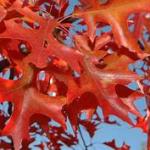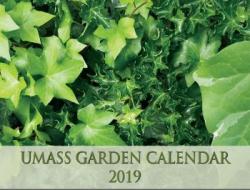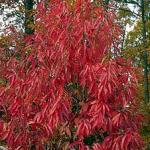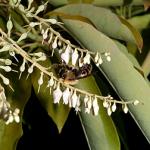A monthly e-newsletter from UMass Extension, published March to October, for home gardeners.
To read the articles in each section of the newsletter, click on the section headings below to expand the content:
Tips of the Month
October is the Month to.....
-
Complete any fall planting so that plants have time to establish root systems. In general, evergreens need planted by late September/early October, whereas deciduous trees can be planted through October. Make sure to keep watering as needed - it's important for plants to be well established to survive the winter.
-
Perform fall clean up. Rake leaves and cut back spent perennials. Be sure to remove plant debris to prevent disease and pests from occurring next year.
-
Get a soil test to determine if lime should be applied. Fall is the best time since the wait time at the lab is much shorter and any needed lime applied in the fall has enough time to change soil pH by next spring. For more info, go to the UMass Soil and Plant Nutrient Testing Lab at soiltest.umass.edu.
-
Drain irrigation systems and hoses. Be sure to keep access to water when needed for fall planted plants.
-
Fall bulb planting tips:
• Bulbs should be planted when nighttime temperatures average between 40-50 degrees F.
• Plant 6-8 weeks before the ground freezes.
• Plant in well-drained soil in areas that will be sunny in the spring at the time of bulb emergence.
• Smaller bulbs are planted approximately 5” deep (crocus and grape hyacinth), whereas larger bulbs should be planted about 8” deep (most tulips, daffodil, allium). The general rule for planting depth is three times the height of the bulb. Make sure the growing tip is up!
• It is important that bulbs are planted in time for rooting to occur so that winter freezing and thawing doesn’t push bulbs out of the ground.
• Fertilizer needs to be in the root zone area. Any fertilizer applied is to support the bulb for the following year, as the bulb already has the reserves it needs to flower in the spring. -
Bury plants that were infected by powdery mildew and other foliar diseases. Most diseases that infect plant leaves do not survive underground.
-
Plant garlic by the end of October to give them time to develop a strong root system. In New England, garlic yields a larger crop when planted in the fall rather than spring.
-
Pot up amaryllis bulbs at two to three week intervals through November and December for a continuous show of the large and showy flowers. Blooms appear about a month from the time the bulb is started.
-
Place mulches over flower beds and around roses when the ground begins to freeze. A 3 or 4 inch layer of mulch is all that's needed. Pine needles, pine boughs, straw, salt marsh hay or shredded oak leaves can be used for mulching. The purpose of winter mulch is to prevent root injury from alternate freezing and thawing cycles rather than to protect the plants from cold temperatures.
-
Don't neglect fallen leaves on the lawn. A thick layer of leaves will smother grass plants. Rake up the leaves and put them on the compost pile.
-
Lower cutting height of the lawn mower by ½ inch with the next mowing. Continue lowering the cutting height by ½ inch with each subsequent mowing until a final cutting height of 1 ½ to 2 inches is achieved. Keep mowing at that setting as long as grass continues to grow - that may be as late as December.
-
Sift compost through a screen of quarter inch mesh and spread the compost over lawns, no more than 1/4 inches deep. Rake the lawn to help the compost settle between the grass plants. This top-dressing of compost helps keep the soil biologically active, supplies some nutrients, aids in the breakdown of thatch, and suppresses turf grass diseases.
-
Don't shear shrubs now since it can stimulate growth. New growth occurring this time of the year may not have time to harden prior to onset of cold weather and may therefore be damaged or killed. On the other hand, any dead, diseased, or damaged branches should be pruned.
-
Take advantage of the soft, moist soils now to grub out roots of invasive plants such as honeysuckle, briars, sumac, bittersweet and poison ivy (protect your skin - even the roots contain the irritating chemical).
-
This is the last issue of Garden Clippings for 2018 - see you in March!
Mandy Bayer, Extension Assistant Professor of Sustainable Landscape Horticulture, University of Massachusetts Amherst
Timely Topics
Oaks & Acorns
 Oaks are one of the more common trees species throughout much of Massachusetts. Oaks are members of the Fagaceae family, which also includes beech and chestnut. There are more than 500 species of oak worldwide and there are more than a dozen species that can be found in Massachusetts. The most common species in Massachusetts include white oak (Quercus alba), swamp white oak (Q. bicolor), scarlet oak (Q. coccinea), bear oak (Q. ilicifolia), dwarf chinquapin-oak (Q. prinoides), chestnut oak (Q. montana), red oak (Q. rubra) and black oak (Q. veluntina). Oaks can be difficult to identify to species because they are capable of hybridizing naturally. Often, we differentiate oaks simply by group - the red group or white group; this level of identification is much easier.
Oaks are one of the more common trees species throughout much of Massachusetts. Oaks are members of the Fagaceae family, which also includes beech and chestnut. There are more than 500 species of oak worldwide and there are more than a dozen species that can be found in Massachusetts. The most common species in Massachusetts include white oak (Quercus alba), swamp white oak (Q. bicolor), scarlet oak (Q. coccinea), bear oak (Q. ilicifolia), dwarf chinquapin-oak (Q. prinoides), chestnut oak (Q. montana), red oak (Q. rubra) and black oak (Q. veluntina). Oaks can be difficult to identify to species because they are capable of hybridizing naturally. Often, we differentiate oaks simply by group - the red group or white group; this level of identification is much easier.
| Feature | Red Oak Group | White Oak Group |
|---|---|---|
| Leaves | Bristles at the tips of lobes, pointed lobes | Without bristles, rounded lobes |
| Bark* | Dark grey, ridges and furrows | Light grey, flaky or platy bark |
| Buds* | Larger & pointed | Smaller & blunt |
| Acorns | Take 2 years to develop, germinate in spring | Take 1 year to develop, germinate in fall |
| Species | Scarlet oak, bear oak, red oak, black oak | White oak, swamp white oak, dwarf chinquapin oak, chestnut oak |
* Not always discernable due to age, growth rate, and/or genetics
Oaks are an extremely important genera of trees for wildlife, providing both habitat and food resources. Research on oaks in the mid-Atlantic region found oaks to be larval hosts for more than 500 species of moths and butterflies. Oaks also provide acorns, which are a major food source for white-footed mice, squirrels, chipmunks, turkeys, grouse, deer, bears, and many others.
An acorn crop is referred to as hard mast. The size of the mast crop can have a significant effect on wildlife populations. Recently, research has also found a link between acorn crops, white-white footed mice, and Lyme disease. The acorns are a major food source for white-footed mice, allowing populations to increase. White-footed mice are also a host for black legged ticks which carry Lyme disease. The subsequent increase in mice and ticks results in more black legged tick nymphs carrying Lyme, two years after the major acorn crop.
When acorns are produced in mass quantities synchronously across a species and a large region, it is referred to as a mast year or mast seeding. Mast years can have a big effect on wildlife populations and oak regeneration. Folklore suggests that heavier crops of acorns are predictors of rough winters. Researchers have attempted to determine what causes this mast seeding phenomenon with little consensus; like most aspects of biology, it is complex.
The production of acorns has been found to be extremely variable amongst individuals, species, years, and location. Some oaks are good producers and others poor producers of acorns; this is likely related to genetics. Another factor in acorn mast is weather. Spring temperatures, summer temperatures, summer moisture, and spring frosts are among just a few of the weather-related factors that have been correlated to acorn mast. This makes it even more complex for oaks in the red group, as these conditions have been shown to affect crop size in the year of flower initiation and the two years of development. Basically, conditions three years ago could affect what you see on the ground today for some oaks.
Previous acorn crop size may also influence current crop size - similar to fruit crops that are biennial bearing, in which a heavy crop is followed by a particularly light crop. Oak trees can also manage crop size by prematurely aborting fruit. Premature acorn abortion can be a response to tree stress, environmental conditions, or to manage crop load.
In the end, there are numerous factors involved in whether there is an abundance of acorns or not. So, whether you curse them for making your sidewalk like skating on marbles or enjoy them for increasing populations of game animals, I wouldn’t bet it will be a rough winter based on acorns.
Russ Norton, Agriculture & Horticulture Extension Educator, Cape Cod Cooperative Extension
News for Gardeners
The 2019 UMass Extension Garden Calendar is Now Available!
 Gardening is enjoyed by so many people — it can ease stress, keep you limber, and even improve your mood! To help keep your plants healthy, productive, and beautiful, the 2019 UMass Garden Calendar offers helpful guidelines, daily tips, and an inspiring garden image each month!
Gardening is enjoyed by so many people — it can ease stress, keep you limber, and even improve your mood! To help keep your plants healthy, productive, and beautiful, the 2019 UMass Garden Calendar offers helpful guidelines, daily tips, and an inspiring garden image each month!
For many years, UMass Extension has worked with the citizens of Massachusetts to help them make sound choices about growing, planting and maintaining plants in their landscapes, including vegetables, backyard fruits, and ornamental plants. Our 2019 calendar continues UMass Extension’s tradition of providing gardeners with useful information. This year’s calendar features the use of tomography to identify internal decay in mature trees that do not yet show any visible symptoms of damage, making it difficult to assess their potential risk in urban and suburban settings.
Each Month Features
- An inspiring garden image
- Daily gardening tips for Northeast growing conditions
- Daily sunrise and sunset times
- Phases of the moon
- Plenty of room for notes
- Low gloss paper for easy writing
Cost: $14
ORDER ONLINE at www.umassgardencalendar.org
Trouble Maker of the Month
Fall is the Time to Think About Winter Annual Weeds
As the end of the gardening season grows near, gardeners often let their guard down. This unfortunately can have consequences for their gardens and landscapes, as some weed are still very active.
As the season closes, it is wise to shift your focus to weeds with a winter annual life cycle. Winter annual weeds germinate in late summer and fall. They grow vegetatively and then go dormant with the arrival of cold weather. In the spring, they continue to grow vegetatively early and then switch to a reproductive phrase during which they flower and produce seed. After flowering, they die with the onset of warm weather. I often refer to winter annual weeds as the “forgotten life cycle” because they appear at a time of the year when we may not be paying attention. Winter annual weeds can be just as problematic and troublesome as summer annual weeds.
Common winter annual weeds in the landscape, lawn and garden (photos of these winter annuals can be viewed at http://extension.umass.edu/landscape/weed-herbarium)
- mouse-ear cress (Arabidopsis thaliana)
- thymeleaf sandwort (Arenaria serpyllifolia)
- downy brome (Bromus tectorum)
- shepherd's-purse (Capsella bursa-pastoris)
- bittercress (Cardamine hirsuta)
- sticky chickweed (Cerastium viscosum)
- horseweed (Conyza canadensis)
- spring whitlowgrass (Draba verna)
- henbit (Lamium amplexicaule)
- red deadnettle (Lamium purpureum)
- field pepperweed (Lepidium campestre)
- Virginia pepperweed (Lepidium virginicum)
- pineappleweed (Matricaria matricariodes)
- annual bluegrass (Poa annua)
- knawel (Scleranthus annuus)
- common chickweed (Stellaria media)
- field pennycress (Thlaspi arvense)
- corn speedwell (Veronica arvensis)
- purslane speedwell (Veronica peregrina)
Winter annual weed management options
Landscape: Apply a fresh, thin layer (about one inch) of landscape mulch in very late summer or early fall to prevent winter annual weeds for establishing. Weeds that have germinated and are very small can to smothered by mulching. Larger weeds can to treated with a glyphosate-based product as a direct spray. Non-chemical products containing clove oil, citric acid, acetic acid, or orange extract can also be used as a directed-spray to control winter annual weeds. Larger weeds occurring mid- to late fall can be physically removed by hand pulling.
Vegetable garden: After fall garden cleanup is done, consider sowing a cover crop of winter rye or oats. These grasses will compete with any winter annual weeds; the cover crop can then be tilled in the follow spring. Cover crops will also prevent water/winter erosion and over time will build soil organic matter.
Randy Prostak UMass Extension Weed Specialist
Plant of the Month
Oxydendrum arboreum, Sourwood
Sourwood, Oxydendrum arboretum, is a wonderful small tree with multi season interest. Sourwood has great fall foliage with colors ranging from yellow to red and purple, often with all three colors at the same time. Sourwood also has delightful summer flowers - hanging racemes of white flowers a little reminiscent of lily of the valley. The flowers give way to persistent fruit capsules that remain on the tree into winter. The foliage is an attractive glossy green and similar in appearance to peach leaves.
Sourwood is a North American native commonly seen in the Southern Appalachians and hardy in USDA zones 5-9. The tree grows approximately 25-30 feet tall with a spread of about 20 feet; in the wild it can reach heights of 60 feet. The tree is slow growing with a pyramidal to rounded habit. Sourwood grows best in slightly acidic, well drained soils with medium moisture. Sourwood is intolerant of compacted soil, excessively drained soil, or root disturbance and therefore not a great option in urban settings. Younger transplants of balled and burlaped or container grown plants are better than older, larger specimens.
The genus name, oxys (acid) and dendron (tree), as well as the common name sourwood give reference to the bitter or sour taste of the leaves. Conversely, the flowers are highly attractive to bees and sourwood honey is highly prized. The small tree makes a great residential specimen or used in the border with other Ericaceae plants such as Leucothoe, Pieris, Rhododendron, or Vaccinium.
Russ Norton, Agriculture & Horticulture Extension Educator, Cape Cod Cooperative Extension
Additional Resources
Landscape Message - for detailed timely reports on growing conditions and pest activity
Home Lawn and Garden Resources
Find us on Facebook! www.facebook.com/UMassExtLandscape/
Follow us on Twitter for daily gardening tips and sunrise/sunset times. twitter.com/UMassGardenClip
Diagnostic Services
The UMass Extension Plant Diagnostic Lab provides, for a fee, woody plant and turf disease analysis, woody plant and turf insect identification, turfgrass identification, weed identification, and offers a report of pest management strategies that are research based, economically sound and environmentally appropriate for the situation. Accurate diagnosis for a turf or landscape problem can often eliminate or reduce the need for pesticide use. Sampling procedures, detailed submission instructions and a list of fees.
The UMass Soil and Plant Nutrient Testing Laboratory at the University of Massachusetts Amherst provides test results and recommendations that lead to the wise and economical use of soils and soil amendments. The Routine Soil Analysis fits the needs of most home gardeners. Sampling procedures plus the different tests offered and a list of fees.
Spread the Word!
Share this newsletter with a friend! New readers can subscribe to our Home Gardener E-Mail List.

